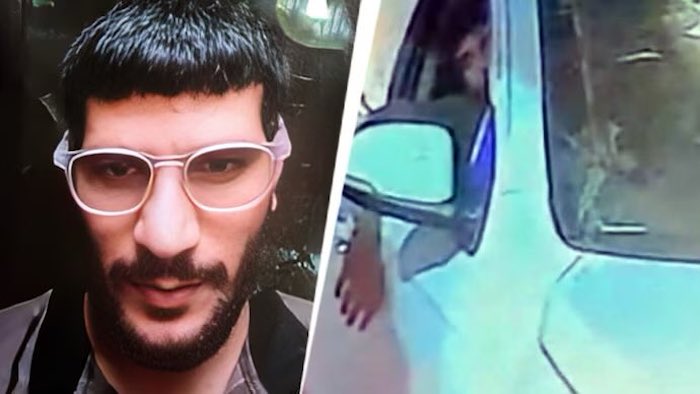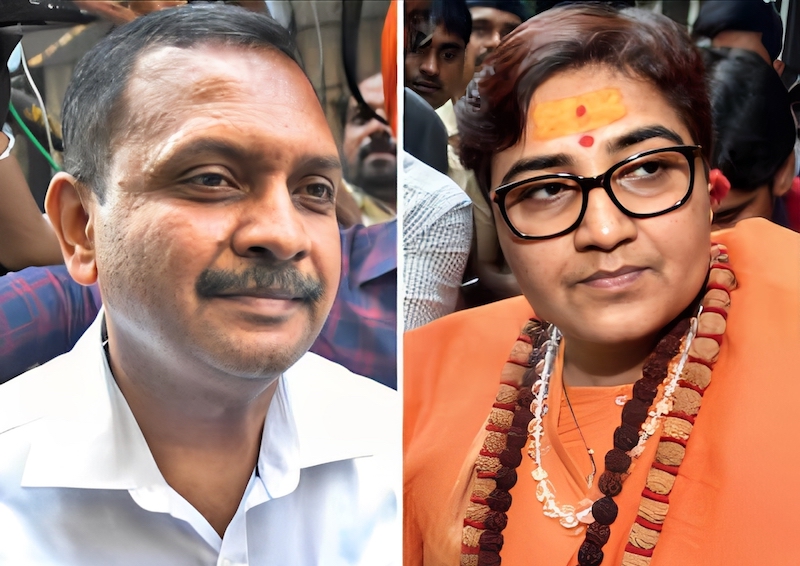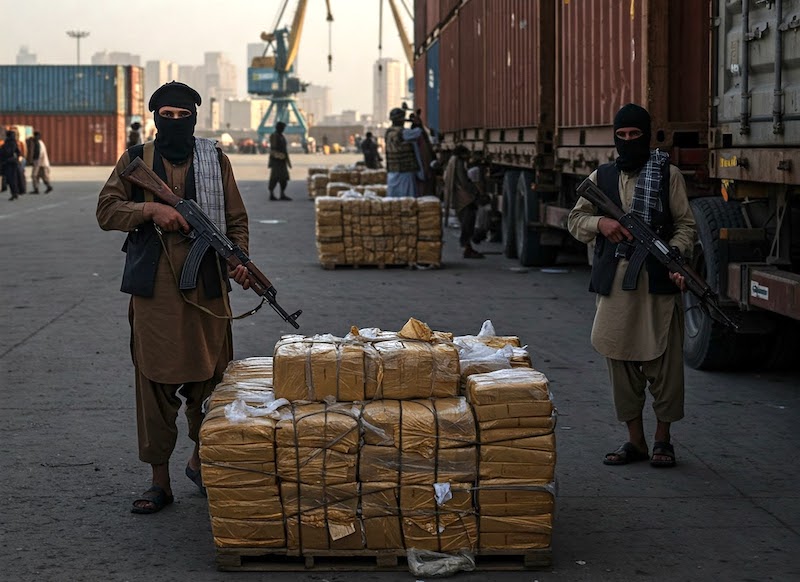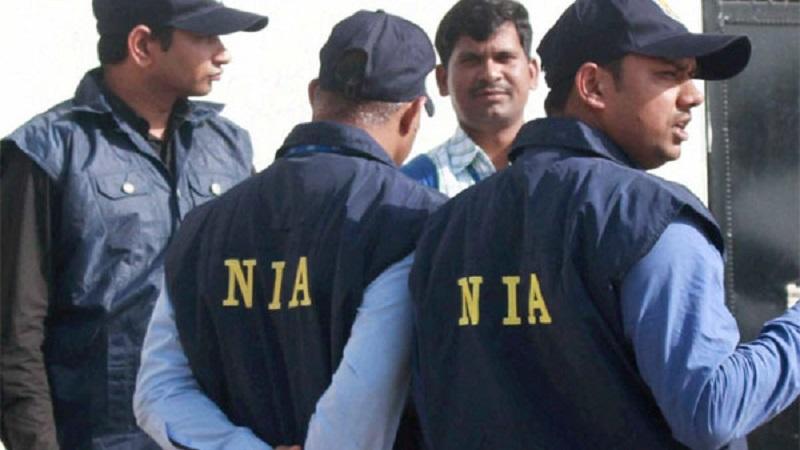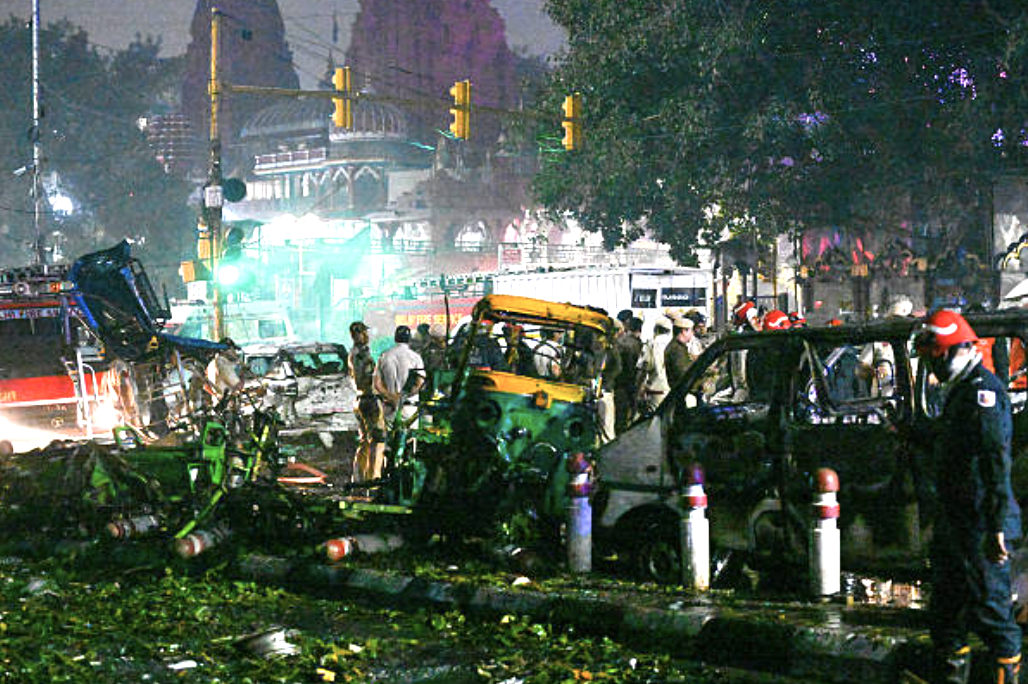 The site of the explosion near the Red Fort, Delhi.
The site of the explosion near the Red Fort, Delhi.
New Delhi: At least nine people were killed and 20 injured when a car exploded at a busy traffic intersection near Delhi’s Red Fort on Monday evening, triggering a massive security alert across India and raising questions about a possible link to a major explosives seizure earlier in the day.
The blast occurred at 6.52pm at Gate No. 1 of the Red Fort Metro station on Netaji Subhash Marg, one of Old Delhi’s busiest commercial thoroughfares. A white Hyundai i20 with a Haryana registration exploded while stationary at a red light, engulfing the vehicle in flames and scattering debris across a 20–25-metre radius.
The force of the explosion shattered windows in nearby buildings, set multiple vehicles ablaze, and scattered human remains across the street. Six cars, two electric rickshaws and one autorickshaw were completely destroyed. Delhi Fire Services brought the blaze under control by 7.29pm after deploying seven to ten fire tenders.
“An explosion happened in that vehicle, and due to the explosion, nearby vehicles were also damaged,” the Delhi Police commissioner, Satish Golcha, told reporters at the scene. He confirmed that two to three people were believed to be inside the car at the time of the blast.
Eyewitnesses described scenes of chaos and terror. “The blast was so intense it felt like the earth caved in,” said one witness, who described people trampling over each other while fleeing in panic. Local resident Rajdhar Pandey said the explosion shook windows in his nearby home. “There was a loud explosion. Windows were shaken with the intensity,” he said.
The gruesome aftermath left emergency responders confronting scattered body parts and vehicle fragments. “First we saw lungs and we were taken aback,” recounted one local resident. “When we saw someone’s hand on the road, we were absolutely shocked.”
The injured were taken to Lok Nayak Jai Prakash Narayan Hospital, where Dr Manish Kumar Jha said more than 30 people had been “badly injured” in the blast. “Many are not in a position of recovering,” he said.
Investigation underway
The Union home minister, Amit Shah, said forensic and counterterrorism teams had been deployed within 10 minutes of the blast. The National Investigation Agency, National Security Guard, and forensic science teams have begun a thorough investigation, he said.
“We are probing all angles. We are exploring all possibilities and will conduct a thorough investigation,” Shah told reporters. When asked whether the incident was a terrorist attack, he replied: “It is difficult to say what caused the incident. Until the samples recovered from the blast site are analysed by forensics and the NSG, we can’t say anything. But we are not ruling out anything.”
The Delhi Police have registered a case under the Unlawful Activities (Prevention) Act, invoking sections dealing with punishment and conspiracy for terrorist attacks, along with provisions of the Explosives Act.
Initial investigations revealed the Hyundai i20 was registered to a Gurgaon resident named Mohammad Salman, though the vehicle had changed hands several times in recent weeks. CCTV footage showed the car entering a parking lot near the Sunehri Masjid at approximately 3.19pm and remaining there until 6.48pm, just minutes before the explosion.
Police sources noted unusual aspects of the blast. “We have not found any pellet or puncture in the body of the injured, which is unusual in a bomb blast,” a source said. The explosion did not create a crater, and victims showed no typical splinter wounds associated with conventional bomb blasts.
Link to Faridabad explosives seizure
The blast occurred hours after police discovered approximately 2,900 kilograms of bomb-making materials in Faridabad, Haryana, just 50 kilometres from Delhi, raising immediate concerns about a potential connection.
In a coordinated operation on Monday, Jammu & Kashmir Police, working with Haryana police, arrested two Kashmiri doctors and busted what they described as an “interstate and transnational terror module” linked to the banned organizations Jaish-e-Muhammed and Ansar Ghazwat-ul-Hind.
Dr Muzammil Ahmad Ganai, who worked at Al Falah Hospital in Faridabad, was arrested from his rented accommodation. Investigators recovered 2,563 kilograms of explosives from one location and approximately 360 kilograms of suspected ammonium nitrate from another site near Al Falah University.
Police also seized a Chinese Star pistol, a Beretta pistol, an AK-56 rifle, an AK Krinkov (another name for AKS-74U, which is an AK-74 variant) assault rifle, and equipment including timers, batteries, remote controls and electronic circuits used in manufacturing improvised explosive devices.
Dr Adeel Ahmad Rather, from Qazigund in south Kashmir, was arrested from Saharanpur in Uttar Pradesh. Police discovered an AK-47 rifle hidden in a bank locker in his possession.
The investigation began after police spotted freshly pasted Jaish-e-Muhammed posters threatening “revenge attacks” in Srinagar on October 19. Police described the network as a “white collar terror ecosystem” involving educated professionals who used their social legitimacy to build infrastructure for terrorist activities. Investigators believe the group was planning to manufacture hundreds of powerful improvised explosive devices to carry out serial blasts across Delhi and other northern states.
Nationwide alert
Following the explosion, Delhi was placed on high alert, with heightened security at Indira Gandhi International Airport, railway stations and bus terminals. The Central Industrial Security Force put all Delhi-NCR installations, including metro stations, the Red Fort monument and government buildings, on high alert.
Mumbai, Kolkata, Bengaluru, Jaipur, Haryana, Punjab, Hyderabad, Uttar Pradesh and Uttarakhand also stepped up security measures. Bihar, which was set to vote in the second and final round of polling on November 11, heightened security at polling stations. Major railway stations across the country were placed on high alert.
Security was tightened at the Delhi-Noida border, with thorough vehicle checks. Uttarakhand deployed mobile units, patrol cars, bomb disposal squads and dog squads across borders and crowded locations. Hyderabad police intensified patrolling in crowded areas with targeted checks at hotels and lodges.
The Delhi chief minister, Rekha Gupta, appealed to residents to “avoid rumours and maintain peace” and urged people to rely only on official information. She announced immediate financial assistance: ₹10 lakh for families of those killed, ₹5 lakh for those permanently disabled, and ₹2 lakh for the seriously injured.
The prime minister, Narendra Modi, expressed condolences to the families of those killed. “Condolences to those who have lost their loved ones in the blast in Delhi earlier this evening. May the injured recover at the earliest,” Modi wrote on X.
The 17th-century Red Fort, built during the Mughal era, is one of India’s most recognizable landmarks and the site where prime ministers deliver annual Independence Day speeches. The blast occurred in a densely populated area near Chandni Chowk Market, one of Delhi’s busiest and oldest markets, which sees between 400,000 and 600,000 daily visitors.
Shah scheduled a high-level meeting for 9.30am on Tuesday to review the investigation’s progress. Whether the explosion was linked to the Faridabad seizure, or represented an isolated incident, remained unclear as investigators worked through the night to determine the cause and identify those responsible.

